


And The Road Goes On:
Camp Verde and Cottonwood, Arizona
May 5th-6th, 2018
by Bud Stratford
Last month, I took another of my ambitious regional road trips around central Arizona- this time to Camp Verde, Sedona, Cottonwood, Clarkdale, Jerome, Chino Valley, and Prescott. It was a pretty relaxing, mellow trip, punctuated with lots of diversions, history, and local lore. As always, I’ve written (and illustrated) around my quick-hit photo-journal of the many skateboarding-related misadventures I lived last weekend. Enjoy…!

Photos, left to right: Rock Springs Cafe, home of the best pie ever; the proof of that lofty pie claim (eat your heart out, Fatty); John Deere 60-Series, illustration by the author.
I started the weekend off right with The Breakfast of Champions at the famous Rock Springs Cafe in Black Canyon City. Most people would sensibly opt for the scrambled eggs, or the biscuits and gravy… but not me! Nope, I went straight for the goods: the famous pies, with vanilla ice cream on the side. Yes, for breakfast; I’m not scared of a little unhealthy livin’, nosiree. I even doubled down, and bought two bags of Churro Nuggets… which are basically caramel-candy-covered corn pops… at the farmers’ market next door. FTW…!
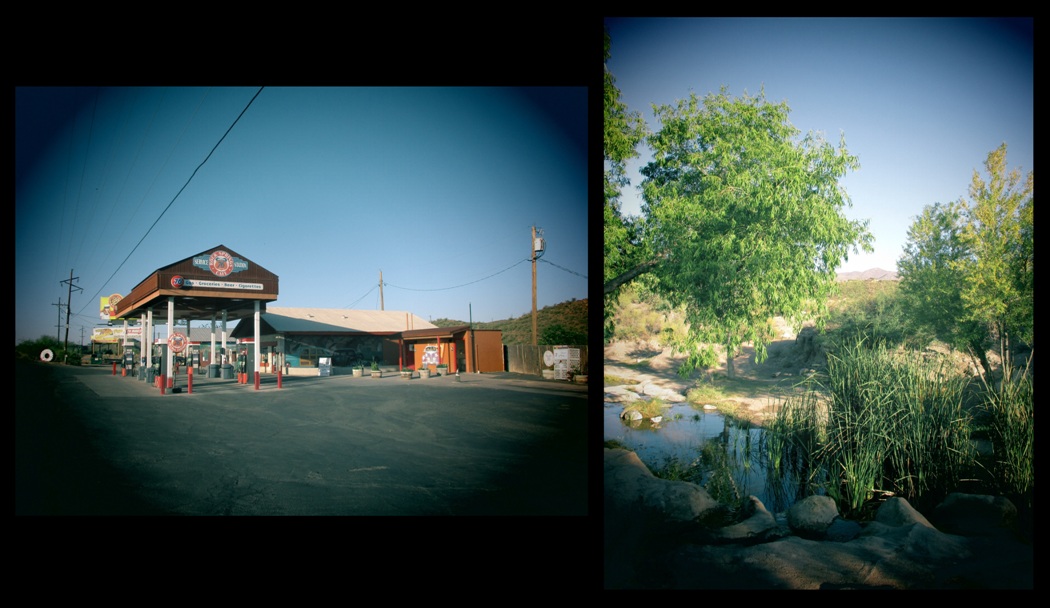
Photos, left to right: the historic gas station at Rock Springs Cafe; the namesake freshwater springs at Rock Springs.
The freshwater springs were a beautiful diversion from my diabetes-cultivating mission. Apparently, they have concerts up here on a pretty regular basis. I made a quick mental note to check one of those out sometime with a hottie on my arm. The make-out opportunities might just make such an endeavor totally worthwhile.

Photos, left to right: Arcosanti, an urban experiment; bronze bells (made on-site at Arcosanti’s foundry) in the gift shop showroom.
Arcosanti takes a little bit of ‘splainin. Concieved in the 1970’s as an experiment in sustainable, off-the-grid urban living, it’s strangely located way out in the boonies just northeast of Cordes Junction. Envisioned as an oasis that might house up to 5000 people, it currently houses less than a tenth of that number. It’s quite a place, though, with functional, yet beautiful, architecture; a mini-museum that honors Paolo Soleri, the visionary founder and steadfast “arcology” proponent; a high-roofed common cafeteria that made for a conveniently cool (and shaded) hydration opportunity; and an extensive gift shop that spotlights the many bronze bells and tiles that are handcrafted in the on-site foundry. Arcosanti offers monthly jazz evenings, Italian dinner events, and has some very plush and spacious accommodations (in the “Sky Suite”) for overnight guests at remarkably reasonable rates. I just might have to take them up on that offer sometime.
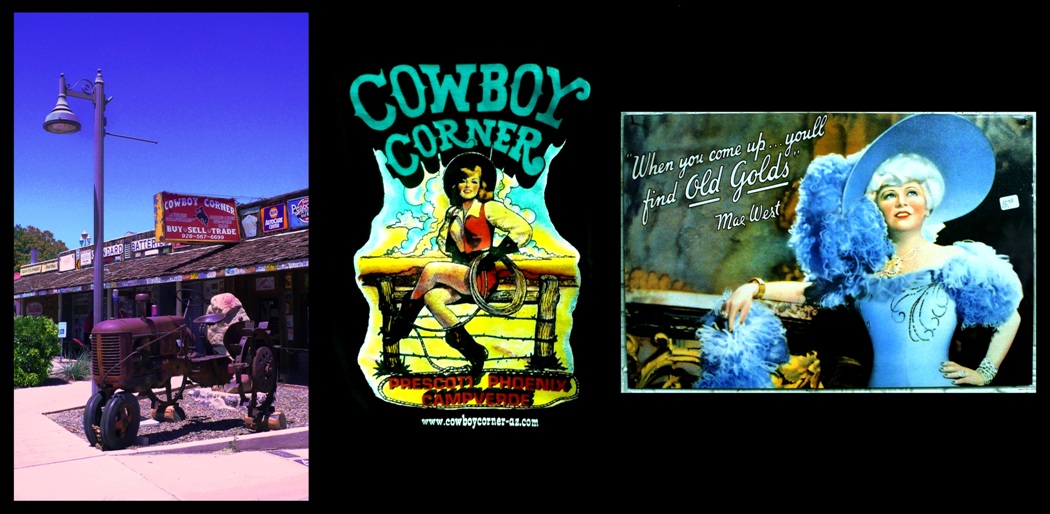
Photos, left to right: Cowboy Corner, Camp Verde, Arizona; Cowboy Corner’s tees; tin advertisement featuring Mae West at Cowboy Corner.

The ditch.
The fellas at Prevent This Tragedy clued me on to this find, so of course I had to go check it out straightaway. It’s right in front of a jail complex, with high security all over the place, and nowhere to park for miles. Thankfully, there was active construction going on nearby that provided a handy place to park (and hide) the camper-combo, and stealthily walk over to the ditch, via an underground culvert, popping up like a gopher every few yards to make sure that I wasn’t walking straight into a security detail or something.
People are funny creatures sometimes. The ditch was fenced off with a very expensive-looking, yet completely non-functional, barricade; it wasn’t hard at all to simply squeeze between the bars, and skate away some of my life away in there. The ditch had a rough-brush finish that is not perfectly ideal, but the big softies always end up carrying the day in these sorts of skate situations. Turns out, that fence stops inexplicably up by the headwall, which allowed me to walk on out of there without hardly any effort at all. So much for “security” and “deterrence”, huh…?
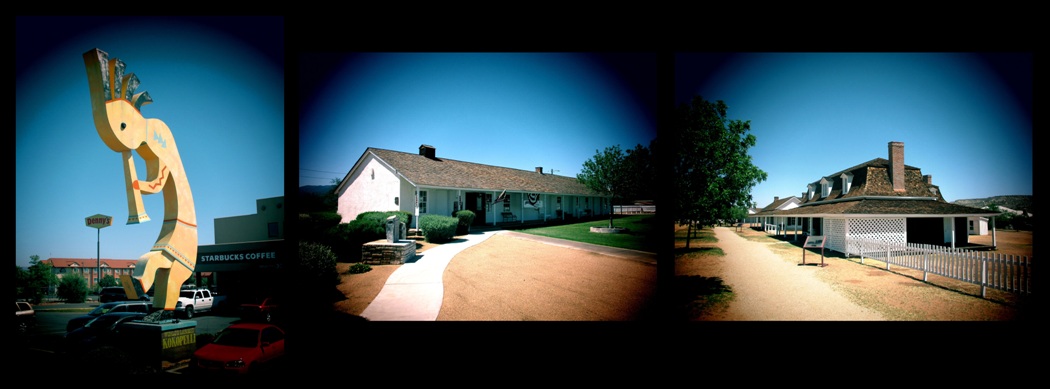
Photos, left to right: The World’s Largest Kokopelli; Fort Verde State Historic Park, Camp Verde, Arizona.
I’m an unapologetic history nerd. You know it, I know it, and everyone else knows it too. Fort Verde was founded in 1871 to basically protect white settlers from the native Indians; later, it’s role changed to making sure that the various Indian tribes stayed within the confines of their respective reservations. Architecturally, Fort Verde was interesting because of it’s lack of stockade walls; my tour guide explained that the fort was so fortified by soldiers and weaponry that the Indians would never even consider advancing on it directly, opting instead for hit-and-run raids on the scouting missions that put troops well out of range of the fort’s defenses.
The most impressive thing about the park was how well they preserved the story of the soldiers’ lives in the camp. It was a difficult, but clearly not impossible, existence. They were resilient and enterprising folks; the expansive vegetable gardens that they built in order to complement their meager Army rations was a testament to their improvisation skills. My guide was an immensely friendly and hospitable chap that took great pride in showing me around and explaining the finer details of the grounds and the museum. I had a really good time at this one.

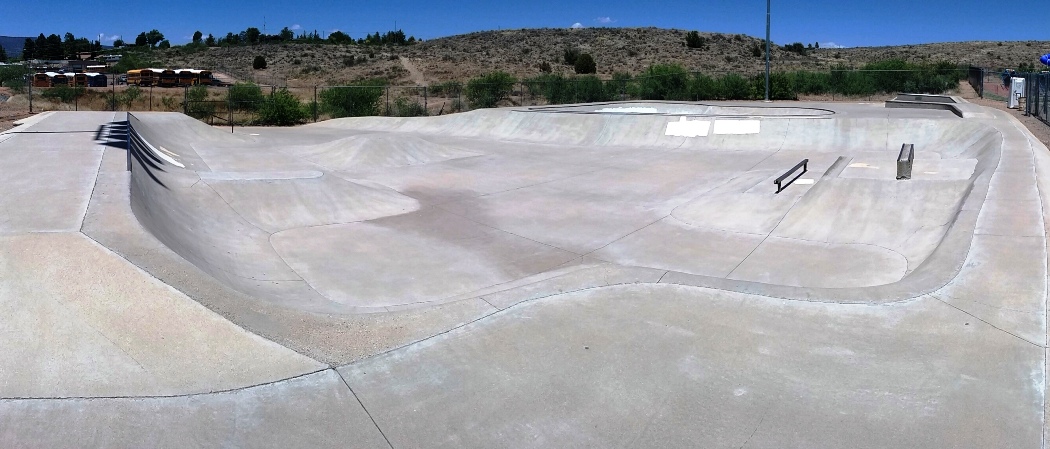
The skatepark in Camp Verde was extremely hit-or-miss. The bowl was just terrible; I’m not sure how I could ever put that “nicely”. Kinky, weird, unskatable transitions everywhere with horribly uneven coping… ug. The “street course”, however, featured the word’s biggest, smoothest loading-dock bank, which made for heaps and tons of great fun.
The trick to dealing with questionable skateparks isn’t in expecting competent design and construction; it’s to expect the worst, and to utilize creative approaches to make the most of the inevitable imperfections.

Left: Artistic deconstruction near Arcosanti. Right: Montezuma Castle.
Tourists are terrible people. I hate them almost universally. They are slow, stupid, slothy fuckers that only serve to jam up public places to the point of crating gridlock everywhere they may choose to congregate. Monetezuma Castle was no exception. The tourists here were even worse than usual, and “the usual” is plenty bad enough.
However, I weathered the tourist trappings for two reasons. First: Montezuma Castle looked pretty fascinating, maybe even worth the frustration of dealing with all the clueless clods. In that regard, I was correct; these adobe Indian ruins precariously perched high off the ground in a natural cave overlooking the river valley were really a sight to behold.
Secondly: the entry fee also got me access to Tuzigoot National Monument in Clarkdale. That was an extremely enticing bonus.
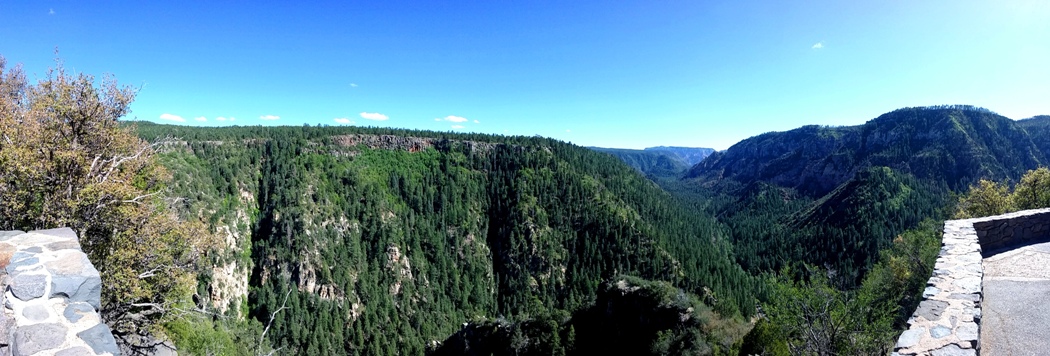
Oak Creek Canyon panoramic
Because I was doing such a swell time sticking to my obsessive-compulsive itinerary, I decided that a quickie diversion might be in order. My wild hairs thought that a nice, leisurely drive through Oak Creek Canyon into Sedona might be the bee’s knees, so off I went to frolic through the forest for an hour or so. Upon descending into Sedona, however, I frightfully discovered that everybody that happened to be out on a road trip through central Arizona (just like I was) had opted for the same exact diversion, backing up route 89A with miles of slow-crawling, stop-and-go traffic. That noted, I decided that my best option might be to stop for a quick lunch at the only McDonald’s in the world with turquise-colored “golden arches”, and make my way to Cottonwood instead.

Left two photos: Cottonwood Skatepark. Right two photos: the locals eagerly enjoying my Deathbox Hackett model.
The afternoon sun was shining brightly, and the stiff wind was blowing a strong circle of dust around the skatepark. There were a few skaters at the Cottonwood skatepark, a friendly find after the tourist hell of Sedona. They immediately wanted to check out and try my trusty Deathbox Dave Hackett model, and I openly encouraged those sorts of shenanigans as I scoped out the scene, shot a bunch of photos, swept the dust and debris from the bowls’ depths, and spotted my lines around the place.
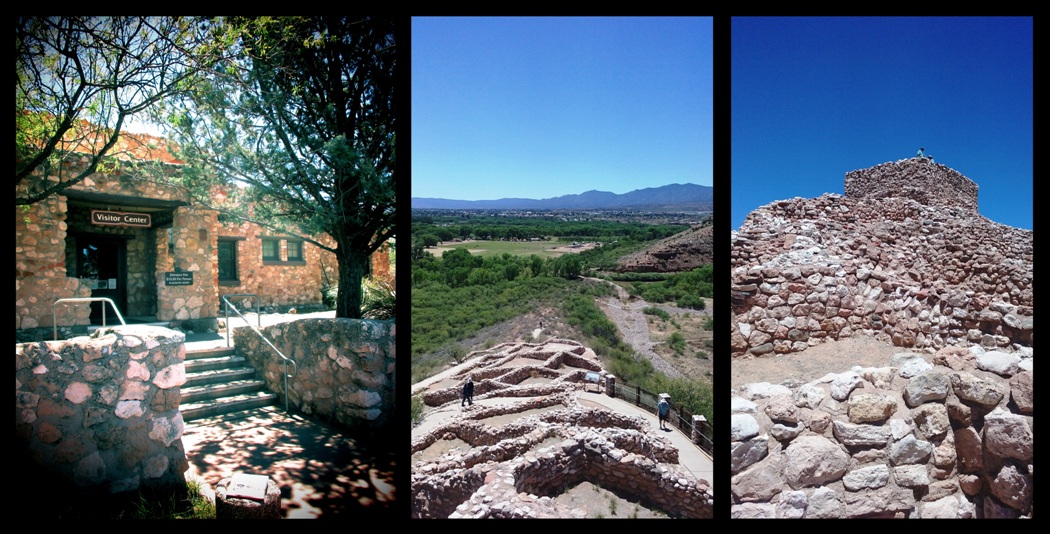
All: Tuzigoot National Monument
Rocks. Basically, what we have here are rocks… lots and lots of rocks… that are mortared together, and stacked up high to create three-story-tall Pueblo ruins. Ruins with a fascinating history and a stellar view of the surrounding valley. The whole time I was there, I was thinking to myself, “Oh, thank God. Thank God that the tourist contingent here is far thinner than it was at Montezuma Castle.” It was really quiet and peaceful, with only a single site volunteer on hand (peacefully playing a reed flute) to pierce the serene silence.

Clockwise from left: Jesus sculpture at the Arizona Copper Art Museum; The Virgin and The Child; wind-up mouse toy sculpture, illustration by the author; the restored Clarkdale high school that houses the current Arizona Copper Art Museum.
I stumble into the strangest things sometimes. The heart of Clarkdale’s historic district features a relatively new museum nestled into the restored high school building, dedicated to “copper art”. Now, I’ve seen some pretty odd ducks in my time, but an entire building dedicated to the creative use of copper is not one of those odd ducks. I decided right away that I just had to check that out.
You’ve never seen so much copper in one place, in your entire life. I certainly haven’t. I was completely bowled over (no pun intended) by how many examples this museum housed. There was cookware of all types and varieties (bowls included); busts and sculptures; embossed illustrations; and most intriguing and unsettling of all, an entire classroom devoted to battlefield sculptures made out of spent artillery shell casings. These would have been widely available castaways, of course, on the Western Front during World War 1. To see them repurpsed, en masse, as sculptures was kind of… well, creepy.

Left to right: my dinner spot in old town Cottonwood, Bing’s Burger Station; 1950 Plymouth Special DeLuxe and Gilmore “Red Lion” Gasoline pump, illustrations by the author; Bing’s interior.
The sun went down far too fast, leaving me stranded without a suitable campsite. The spot that I had chosen by the Verde River had too many rules and too much security for my stealth sensibilities; the last thing I wanted that night was a hassle with the law. There were quite a few industrial-park back lots that looked pretty promising, but nothing that really floated my boat.
On my second suss-out mission around town, I happened upon an Elks lodge that sat high up on a hill, well out of eyesight from the road below. That looked like my sort of spot, so I drove on up to scope it out. The parking lot was large and dark, with only one street light illuminating the grounds- nice! Even better, there were fully developed campsites behind the building, complete with solar-powered lawn lamps- perfect! My stupendously good fortune scores yet another small (but significant) victory.

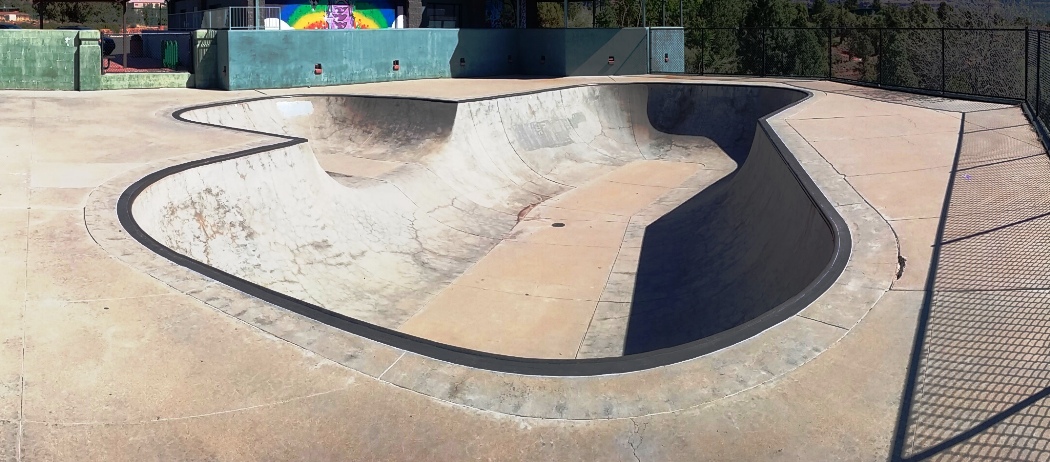
Sedona’s skatepark, Jack Malmgren Skate Park. The only thing in the whole town that’s worth a damn.
Sedona’s a dump, man. Straight out. I woke up early and made my way to the airport overlook to snatch a quick photo of the famous red rocks. I figured that I’d be safe from any touristy-douchery at that time of the morning. Oh, my, how wrong I was.
I drove up to the airport, and saw a sign for “$3 All Day Parking”. Well, I had no intention of staying anywhere near all day. I’d barely be there for more than a few minutes. Assuming that “all day” actually meant “all day”, I drove into the lot, found a space (which was really easy to do,considering that the entire lot was empty), shut the Econobubble down, and made my way to the overlook for my three-minute adventure.
“Hey! You! You have to pay to park here, buddy!”, the guardian of the place hollered from across the lot.
“No problem! How much?!”, I yelled back.
“Three dollars!”
“That’s for all day, bub. I’m only staying a few minutes. How much is that?”
“Same price!”
“You’ve gotta be f’n kidding me, right…?!”
“Hey now, there’s no need to swear at me!”
“I see it quite differently, asshole. You’re seriously gonna charge me the all-day rate for five minutes? How about I throw you a nickel, and you can keep the change, dickwad?” I threw a few pennies on the ground, and told the gate guard to come and pick up his prize. There’s only a zillion photos of Sedona on the internet, anyway. Might as well just steal one of those, and save myself the hassles.
I made my way over to Burger King for a quick breakfast bite, then to the Sedona skatepark to grind out my frustrations. There was one chap there, an older fellow named Caleb, who turned out to be the coolest guy I’d meet in Sedona all weekend. Of course, he was from Georgia, not the Sedona douchebag vortex. That pretty much explains everything, right there.
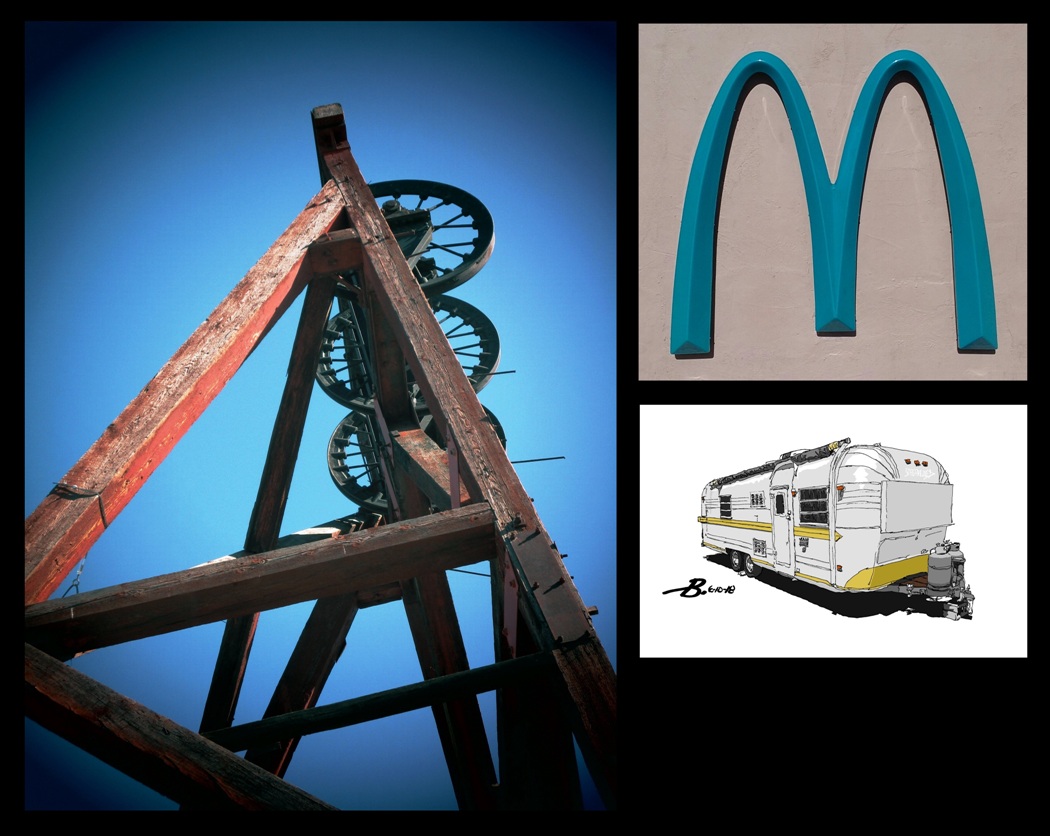
Left: the Audrey Headframe. Upper right: the only McDonald’s in the world with teal arches, Sedona, Arizona. Bottom right: Streamline camper, Clarkdale, Arizona, illustration by the author.
If you don’t know, a “head frame” is the framework that supports the pulleys that drop things down in to, or pulls things out of, a mine shaft. Naturally enough, these frames usually sit right over the shafts themselves, shafts that can reach some pretty severe depths. The shaft under the Audrey Head Frame that sits just outside the wecome gate to Jerome State Historic Park is an awe-inspiring 1900 feet deep, a couple hundred feet taller than the World Trade Center. The only thing that seperates you from the blackness of the shaft’s depths is a single piece of plate glass. I stood on it. It was pretty scary, but I survived.

The drive to Chino Valley was long and lonely. Relaxing, thankfully… but still a bit boring. There’s not much to see out there once you descend out of the mountians, and land in the wide-open grasslands that define the scenescape around the Prescott Valley peripheries.
Chino Valley is a sprawling bedroom community that seems like it is trying to reconcile its western roots with modern conveniences, just like so much of rural America is trying to do to some greater or lesser degree. The one thing that I could not find, however, regardless of how many circles I drove around in, was the skatepark itself.
“Yeah! The skatepark used to be right over there, where the basketball courts are now. Too many kids got broke off in there, so they took everything away a few years back.”
Judging from the GoogleMaps images, it really wasn’t much to look at in the first place, let alone skate. Just a handful of prefab ramps on a concrete slab, stuck out in the far edge of town. Still, I was bummed over the missed opportunity anyway. If I’m going to drive so far to skate something, then I fully expect to skate something.
Even if that “something” is totally crappy.

